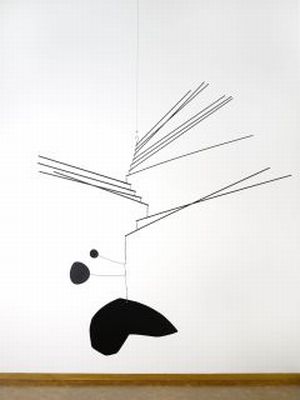ALEXANDER CALDER
THE GREAT DISCOVERY
Gemeentemuseum
Stadhouderslaan 41 - The Hague
11/2/2012 - 28/5/2012
Thanks to a prestigious Turing Art Grant, which made this important exhibition possible, the Gemeentemuseum Den Haag will present Alexander Calder–The Great Discovery, the first major Calder retrospective to be held in the Netherlands since 1969. Calder’s radical wire sculptures, astonishing Cirque Calder (1926–1931), and mobiles characterized by immateriality and movement won the artist worldwide fame and established him as one of the foremost founders of modern sculpture. The exhibition focuses on the legendary meeting between Alexander Calder and Piet Mondrian at the latter’s studio in Paris in October of 1930, and explores the impact the studio environment made on Calder, which left an even more indelible impression on him than the paintings.
Alexander Calder (1898–1976) grew up in a family engaged in artistic traditions: his father was a sculptor and his mother, a painter. As a child, he made model animals, jewelry, and small sculptures from a variety of unconventional materials. Initially training as a mechanical engineer, Calder did not attend art school until 1923 when he enrolled in the Art Students League, New York. Over the rapidly unfolding years that followed, Calder entirely redefined the course of modern sculpture by formalizing movement in art. This was a major innovation: never again would sculpture be seen as a matter of chisels and blocks of wood or stone.
Between 1926 and 1933, Calder lived in Paris, then the heart of the modern art movement. At this stage, he was producing wire sculptures that suggested volume with gestural lines and he became famous for performances of his Cirque Calder, an elaborate miniature circus he had concocted from everyday materials like wire, wood, leather, cork, and scraps of cloth. An early example of performance art, the Cirque was designed to be manipulated by the artist: acrobats swayed across the tightrope, dogs jumped through hoops, and the elephant stood on its hind legs.
The exhibition stems from Calder’s one visit to Mondrian’s studio in 1930, which triggered a radical change in his artistic practice. As Calder later recalled: “It was this visit to Mondrian’s studio […] that made me abstract.” He admired Mondrian’s use of space and converted it into his own artistic expression grounded in gesture and immateriality. A central feature of the forthcoming exhibition is a complete reconstruction of Mondrian’s studio on the Rue du Départ.
The exhibition includes a 1929 film by Hans Cürlis that was shown in the Netherlands in the early 1930s and depicts Calder creating two wire circus figures with no more than a pair of pliers and his own bare hands––profiling the artist as a great innovator with his unorthodox use of materials and methods.
The exhibition concludes with one of Calder’s final works, a circa 1976 design for a sculpture that was to have stood in the sculpture park at the Kröller-Müller Museum, rediscovered during preparations for the exhibition. However, because of Calder’s untimely death in 1976, the project went unrealized.
The exhibition will be accompanied by a lavishly illustrated Dutch-language catalogue (Ludion, € 24.95) containing essays by Wietse Coppes, Doede Hardeman, Hans Janssen, and Caroline Roodenburg-Schadd.
